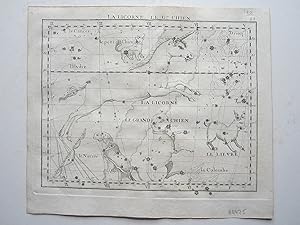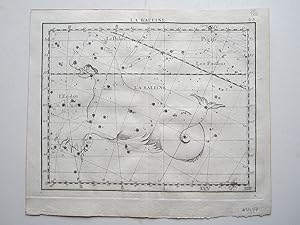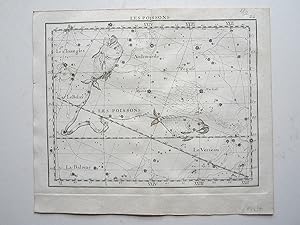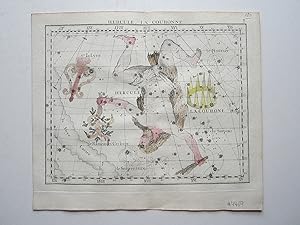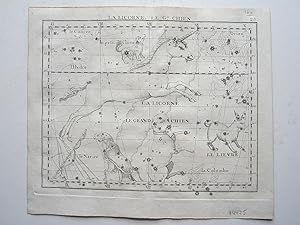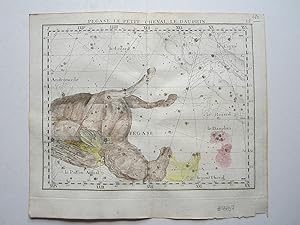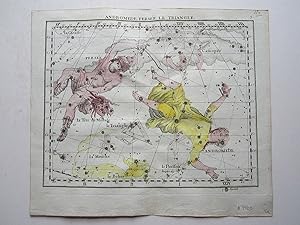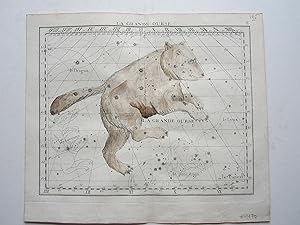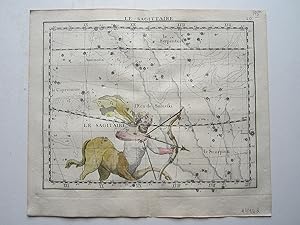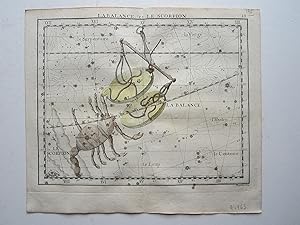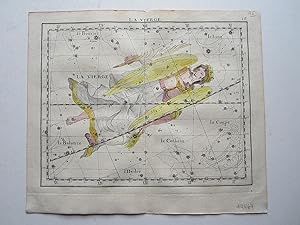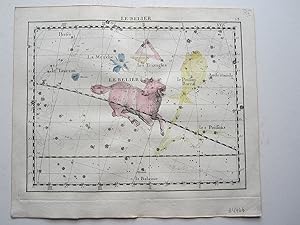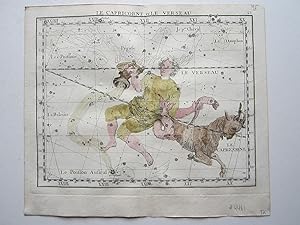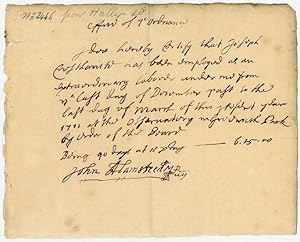flamsteed john 1646 1719 (15 résultats)
Type d'article
- Tous les types d'articles
- Livres (1)
- Magazines & Périodiques
- Bandes dessinées
- Partitions de musique
- Art, Affiches et Gravures
- Photographies
- Cartes (13)
-
Manuscrits &
Papiers anciens (1)
Etat
Reliure
- Toutes
- Couverture rigide (1)
- Couverture souple
Particularités
- Edition originale
- Signé
- Jaquette
- Avec images
- Sans impression à la demande (14)
Pays
Evaluation du vendeur
-
Vorstellung der Gestirne auf XXXIV Kupfertafeln, nach der Pariser Ausg. des Flamsteadschen Himmelsatlas. Durchgehends verbessert und mit den beobachtungen neuerer Astronomen vermehrt nebsteiner Anweisung zum Gebrauch und einem vollstandigen Sternenverzeichnisse von J.E. Bode. (1973) [LeatherBound]
Date d'édition : 2022
Vendeur : S N Books World, Delhi, Inde
Livre impression à la demande
LeatherBound. Etat : New. Leatherbound edition. Condition: New. Leather Binding on Spine and Corners with Golden leaf printing on spine. Bound in genuine leather with Satin ribbon page markers and Spine with raised gilt bands. A perfect gift for your loved ones. Reprinted from 1973 edition. NO changes have been made to the original text. This is NOT a retyped or an ocr'd reprint. Illustrations, Index, if any, are included in black and white. Each page is checked manually before printing. As this print on demand book is reprinted from a very old book, there could be some missing or flawed pages, but we always try to make the book as complete as possible. Fold-outs, if any, are not part of the book. If the original book was published in multiple volumes then this reprint is of only one volume, not the whole set. IF YOU WISH TO ORDER PARTICULAR VOLUME OR ALL THE VOLUMES YOU CAN CONTACT US. Resized as per current standards. Sewing binding for longer life, where the book block is actually sewn (smythe sewn/section sewn) with thread before binding which results in a more durable type of binding. Pages: 158 Language: German Pages: 158.
-
La Licorne, le Gd. Chien. Unicorn, Great Dog.
Edité par F.G.Deschamps, Paris, 1776
Vendeur : Angelika C. J. Friebe Ltd. - MapWoman, Dorking, Royaume-Uni
Carte
No Binding. Etat : Good. copper engraved map; image size 17,5 x 22,5 cm, paper size 22 x 26 cm. fold as issued; indistinctive platemark; shaved to right and top platemark; some discolouration; o/w g cond.- French edition of Flamsteed s celestial atlas, showing the Zodiacs and other celestial constellations. Flamsteed was an English astronomer and was appointed the first Astronomer Royal who catalogued over 3000 stars. From an early age on, he was very interested in astronomy and in 1665, at the age of nineteen, he wrote his first paper on this subject, Mathematical Essays . In 1670, he became an undergraduate at Jesus College in Cambridge, and later became a deacon. In March 1675, he was called to London and was appointed the King s Astronomical Observator with an annual allowance of £100. In June 1675, a Royal Warrant granted the founding of the Royal Greenwich Observatory and in August, Flamsteed laid the foundation stone. He was made a Fellow of the Royal Society in 1676, and eventually moved into the Observatory where he lived until 1684 when he was appointed priest to the parish of Burstow, Surrey. He lived there until his death in 1719. Flamsteed spent 40 years observing and cataloguing stars for his own star catalogue but, afraid to risk his reputation, he kept his findings under lock in Greenwich where they were discovered and published by Newton in 1712 in a pirated star catalogue. Flamsteed, himself uncertain of his findings, obtained 300 of the 400 copies and burned them. In 1725, his version of Historia Coelestis Britannica was published posthumously, containing his own observations of almost 3000 stars with greater accuracy than any other previously known work. in 1729, his wife Margaret published his Atlas Coelestis , followed by a French edition. One of the moon craters has been named after Flamsteed as well as an asteroid.
-
La baleine The Whale.
Edité par F.G.Deschamps, Paris, 1776
Vendeur : Angelika C. J. Friebe Ltd. - MapWoman, Dorking, Royaume-Uni
Carte
No Binding. Etat : Good. copper engraved map; image size 17,5 x 22,5 cm, paper size 22 x 26 cm. fold as issued; indistinctive platemark; shaved to left and top platemark; some discolouration; o/w g cond.- French edition of Flamsteed s celestial atlas, showing the Zodiacs and other celestial constellations. Flamsteed was an English astronomer and was appointed the first Astronomer Royal who catalogued over 3000 stars. From an early age on, he was very interested in astronomy and in 1665, at the age of nineteen, he wrote his first paper on this subject, Mathematical Essays . In 1670, he became an undergraduate at Jesus College in Cambridge, and later became a deacon. In March 1675, he was called to London and was appointed the King s Astronomical Observator with an annual allowance of £100. In June 1675, a Royal Warrant granted the founding of the Royal Greenwich Observatory and in August, Flamsteed laid the foundation stone. He was made a Fellow of the Royal Society in 1676, and eventually moved into the Observatory where he lived until 1684 when he was appointed priest to the parish of Burstow, Surrey. He lived there until his death in 1719. Flamsteed spent 40 years observing and cataloguing stars for his own star catalogue but, afraid to risk his reputation, he kept his findings under lock in Greenwich where they were discovered and published by Newton in 1712 in a pirated star catalogue. Flamsteed, himself uncertain of his findings, obtained 300 of the 400 copies and burned them. In 1725, his version of Historia Coelestis Britannica was published posthumously, containing his own observations of almost 3000 stars with greater accuracy than any other previously known work. in 1729, his wife Margaret published his Atlas Coelestis , followed by a French edition. One of the moon craters has been named after Flamsteed as well as an asteroid.
-
Les Poissons. Fishes
Edité par F.G.Deschamps, Paris, 1776
Vendeur : Angelika C. J. Friebe Ltd. - MapWoman, Dorking, Royaume-Uni
Carte
No Binding. Etat : Good. copper engraved map; image size 17,5 x 22,5 cm, paper size 22 x 26 cm. fold as issued; indistinctive platemark; shaved to left and top platemark; some discolouration; some paper imperfections; o/w g cond.- French edition of Flamsteed s celestial atlas, showing the Zodiacs and other celestial constellations. Flamsteed was an English astronomer and was appointed the first Astronomer Royal who catalogued over 3000 stars. From an early age on, he was very interested in astronomy and in 1665, at the age of nineteen, he wrote his first paper on this subject, Mathematical Essays . In 1670, he became an undergraduate at Jesus College in Cambridge, and later became a deacon. In March 1675, he was called to London and was appointed the King s Astronomical Observator with an annual allowance of £100. In June 1675, a Royal Warrant granted the founding of the Royal Greenwich Observatory and in August, Flamsteed laid the foundation stone. He was made a Fellow of the Royal Society in 1676, and eventually moved into the Observatory where he lived until 1684 when he was appointed priest to the parish of Burstow, Surrey. He lived there until his death in 1719. Flamsteed spent 40 years observing and cataloguing stars for his own star catalogue but, afraid to risk his reputation, he kept his findings under lock in Greenwich where they were discovered and published by Newton in 1712 in a pirated star catalogue. Flamsteed, himself uncertain of his findings, obtained 300 of the 400 copies and burned them. In 1725, his version of Historia Coelestis Britannica was published posthumously, containing his own observations of almost 3000 stars with greater accuracy than any other previously known work. in 1729, his wife Margaret published his Atlas Coelestis , followed by a French edition. One of the moon craters has been named after Flamsteed as well as an asteroid.
-
Hercule, La Couronne. Hercules, Crown.
Edité par F.G.Deschamps, Paris, 1776
Vendeur : Angelika C. J. Friebe Ltd. - MapWoman, Dorking, Royaume-Uni
Carte
No Binding. Etat : Good. copper engraved map with hand colouring; image size 17,5 x 22,5 cm, paper size 22 x 26 cm. old as issued; indistinctive platemark; shaved to left and top platemark; some discolouration; o/w g cond.- French edition of Flamsteed s celestial atlas, showing the Zodiacs and other celestial constellations. Flamsteed was an English astronomer and was appointed the first Astronomer Royal who catalogued over 3000 stars. From an early age on, he was very interested in astronomy and in 1665, at the age of nineteen, he wrote his first paper on this subject, Mathematical Essays . In 1670, he became an undergraduate at Jesus College in Cambridge, and later became a deacon. In March 1675, he was called to London and was appointed the King s Astronomical Observator with an annual allowance of £100. In June 1675, a Royal Warrant granted the founding of the Royal Greenwich Observatory and in August, Flamsteed laid the foundation stone. He was made a Fellow of the Royal Society in 1676, and eventually moved into the Observatory where he lived until 1684 when he was appointed priest to the parish of Burstow, Surrey. He lived there until his death in 1719. Flamsteed spent 40 years observing and cataloguing stars for his own star catalogue but, afraid to risk his reputation, he kept his findings under lock in Greenwich where they were discovered and published by Newton in 1712 in a pirated star catalogue. Flamsteed, himself uncertain of his findings, obtained 300 of the 400 copies and burned them. In 1725, his version of Historia Coelestis Britannica was published posthumously, containing his own observations of almost 3000 stars with greater accuracy than any other previously known work. in 1729, his wife Margaret published his Atlas Coelestis , followed by a French edition. One of the moon craters has been named after Flamsteed as well as an asteroid.
-
La Lyre, Le Cigne, Le Lezard, Le Renard. Lyra, Swan, Lizard, Fox.
Edité par F.G.Deschamps, Paris, 1776
Vendeur : Angelika C. J. Friebe Ltd. - MapWoman, Dorking, Royaume-Uni
Carte
No Binding. Etat : Good. copper engraved map with hand colouring; image size 17,5 x 22,5 cm, paper size 22 x 26 cm. fold as issued; indistinctive platemark; shaved to right and top platemark; some discolouration;o/w g cond.- French edition of Flamsteed s celestial atlas, showing the Zodiacs and other celestial constellations. Flamsteed was an English astronomer and was appointed the first Astronomer Royal who catalogued over 3000 stars. From an early age on, he was very interested in astronomy and in 1665, at the age of nineteen, he wrote his first paper on this subject, Mathematical Essays . In 1670, he became an undergraduate at Jesus College in Cambridge, and later became a deacon. In March 1675, he was called to London and was appointed the King s Astronomical Observator with an annual allowance of £100. In June 1675, a Royal Warrant granted the founding of the Royal Greenwich Observatory and in August, Flamsteed laid the foundation stone. He was made a Fellow of the Royal Society in 1676, and eventually moved into the Observatory where he lived until 1684 when he was appointed priest to the parish of Burstow, Surrey. He lived there until his death in 1719. Flamsteed spent 40 years observing and cataloguing stars for his own star catalogue but, afraid to risk his reputation, he kept his findings under lock in Greenwich where they were discovered and published by Newton in 1712 in a pirated star catalogue. Flamsteed, himself uncertain of his findings, obtained 300 of the 400 copies and burned them. In 1725, his version of Historia Coelestis Britannica was published posthumously, containing his own observations of almost 3000 stars with greater accuracy than any other previously known work. in 1729, his wife Margaret published his Atlas Coelestis , followed by a French edition. One of the moon craters has been named after Flamsteed as well as an asteroid.
-
Pegase, le Petit Cheval, et le Dauphin. Pegasus, Little Horse, Dolphin.
Edité par F.G.Deschamps, Paris, 1776
Vendeur : Angelika C. J. Friebe Ltd. - MapWoman, Dorking, Royaume-Uni
Carte
No Binding. Etat : Good. copper engraved map with hand colouring; image size 17,5 x 22,5 cm, paper size 22 x 26 cm. fold as issued; indistinctive platemark; shaved to left and top platemark; lower edge frayed; some discolouration; o/w g cond.- French edition of Flamsteed s celestial atlas, showing the Zodiacs and other celestial constellations. Flamsteed was an English astronomer and was appointed the first Astronomer Royal who catalogued over 3000 stars. From an early age on, he was very interested in astronomy and in 1665, at the age of nineteen, he wrote his first paper on this subject, Mathematical Essays . In 1670, he became an undergraduate at Jesus College in Cambridge, and later became a deacon. In March 1675, he was called to London and was appointed the King s Astronomical Observator with an annual allowance of £100. In June 1675, a Royal Warrant granted the founding of the Royal Greenwich Observatory and in August, Flamsteed laid the foundation stone. He was made a Fellow of the Royal Society in 1676, and eventually moved into the Observatory where he lived until 1684 when he was appointed priest to the parish of Burstow, Surrey. He lived there until his death in 1719. Flamsteed spent 40 years observing and cataloguing stars for his own star catalogue but, afraid to risk his reputation, he kept his findings under lock in Greenwich where they were discovered and published by Newton in 1712 in a pirated star catalogue. Flamsteed, himself uncertain of his findings, obtained 300 of the 400 copies and burned them. In 1725, his version of Historia Coelestis Britannica was published posthumously, containing his own observations of almost 3000 stars with greater accuracy than any other previously known work. in 1729, his wife Margaret published his Atlas Coelestis , followed by a French edition. One of the moon craters has been named after Flamsteed as well as an asteroid.
-
Andromede, Persee, le Triangle. Andromeda, Perseus, Triangle.
Edité par F.G.Deschamps, Paris, 1776
Vendeur : Angelika C. J. Friebe Ltd. - MapWoman, Dorking, Royaume-Uni
Carte
No Binding. Etat : Good. copper engraved map with hand colouring; image size 17,5 x 22,5 cm, paper size 22 x 26 cm. fold as issued; indistinctive platemark; shaved to left and top platemark; some discolouration; additional printer s crease; o/w g cond.- French edition of Flamsteed s celestial atlas, showing the Zodiacs and other celestial constellations. Flamsteed was an English astronomer and was appointed the first Astronomer Royal who catalogued over 3000 stars. From an early age on, he was very interested in astronomy and in 1665, at the age of nineteen, he wrote his first paper on this subject, Mathematical Essays . In 1670, he became an undergraduate at Jesus College in Cambridge, and later became a deacon. In March 1675, he was called to London and was appointed the King s Astronomical Observator with an annual allowance of £100. In June 1675, a Royal Warrant granted the founding of the Royal Greenwich Observatory and in August, Flamsteed laid the foundation stone. He was made a Fellow of the Royal Society in 1676, and eventually moved into the Observatory where he lived until 1684 when he was appointed priest to the parish of Burstow, Surrey. He lived there until his death in 1719. Flamsteed spent 40 years observing and cataloguing stars for his own star catalogue but, afraid to risk his reputation, he kept his findings under lock in Greenwich where they were discovered and published by Newton in 1712 in a pirated star catalogue. Flamsteed, himself uncertain of his findings, obtained 300 of the 400 copies and burned them. In 1725, his version of Historia Coelestis Britannica was published posthumously, containing his own observations of almost 3000 stars with greater accuracy than any other previously known work. in 1729, his wife Margaret published his Atlas Coelestis , followed by a French edition. One of the moon craters has been named after Flamsteed as well as an asteroid.
-
La Grande Ourse. The Great Bear
Edité par F.G.Deschamps, Paris, 1776
Vendeur : Angelika C. J. Friebe Ltd. - MapWoman, Dorking, Royaume-Uni
Carte
No Binding. Etat : Good. copper engraved map with hand colouring; image size 17,5 x 22,5 cm, paper size 22 x 26 cm. fold as issued; indistinctive platemark; shaved to left and top platemark; some discolouration; additional printer s crease; o/w g cond.- French edition of Flamsteed s celestial atlas, showing the Zodiacs and other celestial constellations. Flamsteed was an English astronomer and was appointed the first Astronomer Royal who catalogued over 3000 stars. From an early age on, he was very interested in astronomy and in 1665, at the age of nineteen, he wrote his first paper on this subject, Mathematical Essays . In 1670, he became an undergraduate at Jesus College in Cambridge, and later became a deacon. In March 1675, he was called to London and was appointed the King s Astronomical Observator with an annual allowance of £100. In June 1675, a Royal Warrant granted the founding of the Royal Greenwich Observatory and in August, Flamsteed laid the foundation stone. He was made a Fellow of the Royal Society in 1676, and eventually moved into the Observatory where he lived until 1684 when he was appointed priest to the parish of Burstow, Surrey. He lived there until his death in 1719. Flamsteed spent 40 years observing and cataloguing stars for his own star catalogue but, afraid to risk his reputation, he kept his findings under lock in Greenwich where they were discovered and published by Newton in 1712 in a pirated star catalogue. Flamsteed, himself uncertain of his findings, obtained 300 of the 400 copies and burned them. In 1725, his version of Historia Coelestis Britannica was published posthumously, containing his own observations of almost 3000 stars with greater accuracy than any other previously known work. in 1729, his wife Margaret published his Atlas Coelestis , followed by a French edition. One of the moon craters has been named after Flamsteed as well as an asteroid.
-
Le Sagittaire. Sagitarius.
Edité par F.G.Deschamps, Paris, 1776
Vendeur : Angelika C. J. Friebe Ltd. - MapWoman, Dorking, Royaume-Uni
Carte
No Binding. Etat : Good. copper engraved map with hand colouring; image size 17,5 x 22,5 cm, paper size 22 x 26 cm. fold as issued; indistinctive platemark; shaved to left and top platemark; some discolouration; 2 small indentations; o/w g cond.- French edition of Flamsteed s celestial atlas, showing the Zodiacs and other celestial constellations. Flamsteed was an English astronomer and was appointed the first Astronomer Royal who catalogued over 3000 stars. From an early age on, he was very interested in astronomy and in 1665, at the age of nineteen, he wrote his first paper on this subject, Mathematical Essays . In 1670, he became an undergraduate at Jesus College in Cambridge, and later became a deacon. In March 1675, he was called to London and was appointed the King s Astronomical Observator with an annual allowance of £100. In June 1675, a Royal Warrant granted the founding of the Royal Greenwich Observatory and in August, Flamsteed laid the foundation stone. He was made a Fellow of the Royal Society in 1676, and eventually moved into the Observatory where he lived until 1684 when he was appointed priest to the parish of Burstow, Surrey. He lived there until his death in 1719. Flamsteed spent 40 years observing and cataloguing stars for his own star catalogue but, afraid to risk his reputation, he kept his findings under lock in Greenwich where they were discovered and published by Newton in 1712 in a pirated star catalogue. Flamsteed, himself uncertain of his findings, obtained 300 of the 400 copies and burned them. In 1725, his version of Historia Coelestis Britannica was published posthumously, containing his own observations of almost 3000 stars with greater accuracy than any other previously known work. in 1729, his wife Margaret published his Atlas Coelestis , followed by a French edition. One of the moon craters has been named after Flamsteed as well as an asteroid.
-
La Balance et Le Scorpion. Libra, Scorpio.
Edité par F.G.Deschamps, Paris, 1776
Vendeur : Angelika C. J. Friebe Ltd. - MapWoman, Dorking, Royaume-Uni
Carte
No Binding. Etat : Good. copper engraved map with hand colouring; image size 17,5 x 22,5 cm, paper size 22 x 26 cm. fold as issued; indistinctive platemark; shaved to left and top platemark; some discolouration; 2 small indentations; o/w g cond.- French edition of Flamsteed s celestial atlas, showing the Zodiacs and other celestial constellations. Flamsteed was an English astronomer and was appointed the first Astronomer Royal who catalogued over 3000 stars. From an early age on, he was very interested in astronomy and in 1665, at the age of nineteen, he wrote his first paper on this subject, Mathematical Essays . In 1670, he became an undergraduate at Jesus College in Cambridge, and later became a deacon. In March 1675, he was called to London and was appointed the King s Astronomical Observator with an annual allowance of £100. In June 1675, a Royal Warrant granted the founding of the Royal Greenwich Observatory and in August, Flamsteed laid the foundation stone. He was made a Fellow of the Royal Society in 1676, and eventually moved into the Observatory where he lived until 1684 when he was appointed priest to the parish of Burstow, Surrey. He lived there until his death in 1719. Flamsteed spent 40 years observing and cataloguing stars for his own star catalogue but, afraid to risk his reputation, he kept his findings under lock in Greenwich where they were discovered and published by Newton in 1712 in a pirated star catalogue. Flamsteed, himself uncertain of his findings, obtained 300 of the 400 copies and burned them. In 1725, his version of Historia Coelestis Britannica was published posthumously, containing his own observations of almost 3000 stars with greater accuracy than any other previously known work. in 1729, his wife Margaret published his Atlas Coelestis , followed by a French edition. One of the moon craters has been named after Flamsteed as well as an asteroid.
-
La Vierge Virgo
Edité par F.G.Deschamps, Paris, 1776
Vendeur : Angelika C. J. Friebe Ltd. - MapWoman, Dorking, Royaume-Uni
Carte
No Binding. Etat : Good. copper engraved map with hand colouring; image size 17,5 x 22,5 cm, paper size 22 x 26 cm. fold as issued; indistinctive platemark; shaved to leftt and top platemark; some discolouration; o/w g cond.- French edition of Flamsteed s celestial atlas, showing the Zodiacs and other celestial constellations. Flamsteed was an English astronomer and was appointed the first Astronomer Royal who catalogued over 3000 stars. From an early age on, he was very interested in astronomy and in 1665, at the age of nineteen, he wrote his first paper on this subject, Mathematical Essays . In 1670, he became an undergraduate at Jesus College in Cambridge, and later became a deacon. In March 1675, he was called to London and was appointed the King s Astronomical Observator with an annual allowance of £100. In June 1675, a Royal Warrant granted the founding of the Royal Greenwich Observatory and in August, Flamsteed laid the foundation stone. He was made a Fellow of the Royal Society in 1676, and eventually moved into the Observatory where he lived until 1684 when he was appointed priest to the parish of Burstow, Surrey. He lived there until his death in 1719. Flamsteed spent 40 years observing and cataloguing stars for his own star catalogue but, afraid to risk his reputation, he kept his findings under lock in Greenwich where they were discovered and published by Newton in 1712 in a pirated star catalogue. Flamsteed, himself uncertain of his findings, obtained 300 of the 400 copies and burned them. In 1725, his version of Historia Coelestis Britannica was published posthumously, containing his own observations of almost 3000 stars with greater accuracy than any other previously known work. in 1729, his wife Margaret published his Atlas Coelestis , followed by a French edition. One of the moon craters has been named after Flamsteed as well as an asteroid.
-
Le Bellier Aries
Edité par F.G.Deschamps, Paris, 1776
Vendeur : Angelika C. J. Friebe Ltd. - MapWoman, Dorking, Royaume-Uni
Carte
No Binding. Etat : Good. copper engraved map with hand colouring; image size 17,5 x 22,5 cm, paper size 22 x 26 cm. fold as issued; indistinctive platemark; shaved to right and top platemark; some discolouration; o/w g cond.- French edition of Flamsteed s celestial atlas, showing the Zodiacs and other celestial constellations. Flamsteed was an English astronomer and was appointed the first Astronomer Royal who catalogued over 3000 stars. From an early age on, he was very interested in astronomy and in 1665, at the age of nineteen, he wrote his first paper on this subject, Mathematical Essays . In 1670, he became an undergraduate at Jesus College in Cambridge, and later became a deacon. In March 1675, he was called to London and was appointed the King s Astronomical Observator with an annual allowance of £100. In June 1675, a Royal Warrant granted the founding of the Royal Greenwich Observatory and in August, Flamsteed laid the foundation stone. He was made a Fellow of the Royal Society in 1676, and eventually moved into the Observatory where he lived until 1684 when he was appointed priest to the parish of Burstow, Surrey. He lived there until his death in 1719. Flamsteed spent 40 years observing and cataloguing stars for his own star catalogue but, afraid to risk his reputation, he kept his findings under lock in Greenwich where they were discovered and published by Newton in 1712 in a pirated star catalogue. Flamsteed, himself uncertain of his findings, obtained 300 of the 400 copies and burned them. In 1725, his version of Historia Coelestis Britannica was published posthumously, containing his own observations of almost 3000 stars with greater accuracy than any other previously known work. in 1729, his wife Margaret published his Atlas Coelestis , followed by a French edition. One of the moon craters has been named after Flamsteed as well as an asteroid.
-
Le Sagittaire. Sagitarius.
Edité par F.G.Deschamps, Paris, 1776
Vendeur : Angelika C. J. Friebe Ltd. - MapWoman, Dorking, Royaume-Uni
Carte
No Binding. Etat : Good. copper engraved map with hand colouring; image size 17,5 x 22,5 cm, paper size 22 x 26 cm. fold as issued; indistinctive platemark; shaved to right and top platemark; some discolouration; 2 small indentations; o/w g cond.- French edition of Flamsteed s celestial atlas, showing the Zodiacs and other celestial constellations. Flamsteed was an English astronomer and was appointed the first Astronomer Royal who catalogued over 3000 stars. From an early age on, he was very interested in astronomy and in 1665, at the age of nineteen, he wrote his first paper on this subject, Mathematical Essays . In 1670, he became an undergraduate at Jesus College in Cambridge, and later became a deacon. In March 1675, he was called to London and was appointed the King s Astronomical Observator with an annual allowance of £100. In June 1675, a Royal Warrant granted the founding of the Royal Greenwich Observatory and in August, Flamsteed laid the foundation stone. He was made a Fellow of the Royal Society in 1676, and eventually moved into the Observatory where he lived until 1684 when he was appointed priest to the parish of Burstow, Surrey. He lived there until his death in 1719. Flamsteed spent 40 years observing and cataloguing stars for his own star catalogue but, afraid to risk his reputation, he kept his findings under lock in Greenwich where they were discovered and published by Newton in 1712 in a pirated star catalogue. Flamsteed, himself uncertain of his findings, obtained 300 of the 400 copies and burned them. In 1725, his version of Historia Coelestis Britannica was published posthumously, containing his own observations of almost 3000 stars with greater accuracy than any other previously known work. in 1729, his wife Margaret published his Atlas Coelestis , followed by a French edition. One of the moon craters has been named after Flamsteed as well as an asteroid.
-
Autograph document signed ("John Flamsteed, MR").
Edité par [London, probably 1 April 1712]., 1712
Vendeur : Antiquariat INLIBRIS Gilhofer Nfg. GmbH, Vienna, A, Autriche
Manuscrit / Papier ancien
Oblong 8vo. 1 p. Previously unknown payment certificate for his assistant Joseph Crosthwait, written to the Ordnance Office: "I doe hereby certify that Joseph Crosthwaite has been employed as an extraordinary laborer under me from the last day of December past to the last day of March of this present year 1712 at the Observatory in Greenwich Park by Order of the Board. Being 90 days at 18 d a day - 6.15.00". "A number of similar documents, certifying Crosthwait's quarterly pay at various times, survives in different institutions (though they should properly be part of the Public Records)" (Forbes, p. 931, citing a total of seven known specimens in the Library of the British Astronomical Association, London, Staatsbibliothek Berlin, Edinburgh University Library, Historical Society of Pennsylvania, Columbia University Libraries, and at a 1983 Drouot Sale. - Flamsteed, the first Astronomer Royal, catalogued more than 3000 stars, accurately calculated the solar eclipses of 1666 and 1668, and was responsible for several of the earliest recorded sightings of the planet Uranus. Joseph Crosthwait was his longest serving assistant, remaining with the Observatory from 1708 until Flamsteed's death in 1719. At this point, the whole of the first volume of Flamsteed's "Historia Coelestis Britannica" had been printed together with much of the second. Crosthwait saw the second volume through to completion and organised the preparation and printing of the third. - Cf. Eric C. Forbes (ed.), The Correspondence of John Flamsteed (Bristol/Philadelphia 2002), vol. 3, p. 930f.


![Image du vendeur pour Vorstellung der Gestirne auf XXXIV Kupfertafeln, nach der Pariser Ausg. des Flamsteadschen Himmelsatlas. Durchgehends verbessert und mit den beobachtungen neuerer Astronomen vermehrt nebsteiner Anweisung zum Gebrauch und einem vollstandigen Sternenverzeichnisse von J.E. Bode. (1973) [LeatherBound] mis en vente par S N Books World](https://pictures.abebooks.com/inventory/md/md31650025381.jpg)
